
A propeller is a device with a rotating hub and radiating blades that are set at a pitch to form a helical spiral which, when rotated, exerts linear thrust upon a working fluid such as water or air. Propellers are used to pump fluid through a pipe or duct, or to create thrust to propel a boat through water or an aircraft through air. The blades are shaped so that their rotational motion through the fluid causes a pressure difference between the two surfaces of the blade by Bernoulli's principle which exerts force on the fluid. Most marine propellers are screw propellers with helical blades rotating on a propeller shaft with an approximately horizontal axis.

Naval architecture, or naval engineering, is an engineering discipline incorporating elements of mechanical, electrical, electronic, software and safety engineering as applied to the engineering design process, shipbuilding, maintenance, and operation of marine vessels and structures. Naval architecture involves basic and applied research, design, development, design evaluation (classification) and calculations during all stages of the life of a marine vehicle. Preliminary design of the vessel, its detailed design, construction, trials, operation and maintenance, launching and dry-docking are the main activities involved. Ship design calculations are also required for ships being modified. Naval architecture also involves formulation of safety regulations and damage-control rules and the approval and certification of ship designs to meet statutory and non-statutory requirements.

The Ocean Race is a yacht race around the world, held every three or four years since 1973. Originally named the Whitbread Round the World Race after its initiating sponsor, British brewing company Whitbread, in 2001 it became the Volvo Ocean Race after Swedish automobile manufacturer Volvo took up the sponsorship, and in 2019 it was renamed The Ocean Race.

AB Karlstads Mekaniska Werkstad, known as Kamewa, was a Swedish manufacturing company in the city of Kristinehamn. Kamewa started as a brand name of the controllable-pitch propellers manufactured by KMW. KMW was founded in the city of Karlstad in 1860. KMW also manufactured pulp and paper machines for paper mills and hydro power turbines. Kamewa was acquired by the British company Vickers plc in 1986. In 1999, Rolls-Royce acquired Vickers. In 2019 the Commercial Marine part of Rolls-Royce was acquired by the Kongsberg group and integrated into its maritime division Kongsberg Maritime. The Swedish part of the business is now called Kongsberg Maritime Sweden AB and is based in Kristinehamn.

A ship model basin is a basin or tank used to carry out hydrodynamic tests with ship models, for the purpose of designing a new ship, or refining the design of a ship to improve the ship's performance at sea. It can also refer to the organization that owns and operates such a facility.

A diesel–electric transmission, or diesel–electric powertrain is a transmission system for vehicles powered by diesel engines in road, rail, and marine transport. Diesel–electric transmission is based on petrol–electric transmission, a very similar transmission system used for petrol engines.
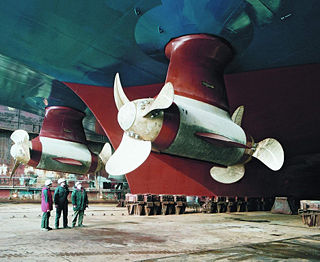
An azimuth thruster is a configuration of marine propellers placed in pods that can be rotated to any horizontal angle (azimuth), making a rudder redundant. These give ships better maneuverability than a fixed propeller and rudder system.
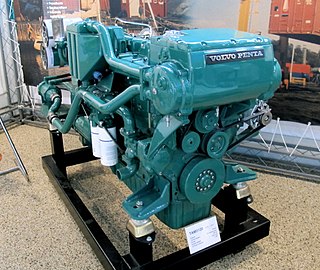
Volvo Penta is a Swedish marine and industrial engine manufacturer, a joint stock company within the Volvo Group. Volvo Penta was founded as Penta in 1907 with the production of its first marine engine, the B1. The Penta company soon became an established internal combustion engine manufacturer, which in 1927 delivered the engine for Volvo's first passenger car.

A Z-drive is a type of marine propulsion unit. Specifically, it is an azimuth thruster. The pod can rotate 360 degrees allowing for rapid changes in thrust direction and thus vessel direction. This eliminates the need for a conventional rudder.

Azipod is a trademark azimuth thruster pod design, a marine propulsion unit consisting of a fixed pitch propeller mounted on a steerable gondola ("pod") containing the electric motor driving the propeller, allowing ships to be more maneuverable. They were developed in Finland in the late 1980s jointly by Wärtsilä Marine, Strömberg and the Finnish National Board of Navigation.

Marine engineering is the engineering of boats, ships, submarines, and any other marine vessel. Here it is also taken to include the engineering of other ocean systems and structures – referred to in certain academic and professional circles as “ocean engineering.”

Marine propulsion is the mechanism or system used to generate thrust to move a watercraft through water. While paddles and sails are still used on some smaller boats, most modern ships are propelled by mechanical systems consisting of an electric motor or internal combustion engine driving a propeller, or less frequently, in pump-jets, an impeller. Marine engineering is the discipline concerned with the engineering design process of marine propulsion systems.

Kenneth Read is an American yachtsman who is considered one of the world's most accomplished and celebrated sailors. He was named United States Rolex Yachtsman of the Year twice, and has won more than 50 world, North American, and national championships in a variety of classes, with eleven of those being World Championships titles in the J/24, Etchells 22 and yacht classes.
William Oxley is a racing skipper/navigator and marine biologist who has completed more than 300,000 nm of ocean racing including five round the world races and 20 Sydney to Hobart races. From 1992 to 2000 he worked at the Australian Institute of Marine Science as part of the Long-term Monitoring Project which is intended to monitor the condition of the Great Barrier Reef.

The 2011–12 Volvo Ocean Race was the 11th edition of the round-the-world Volvo Ocean Race, yacht race which started with an in-port race in Alicante, Spain on 29 October 2011 with six Volvo Open 70 yachts at the start line and ended with an in-port race in Galway, Ireland on 7 July 2012. The 39,270 NM route involved stopovers and in-port races in Cape Town, Abu Dhabi, Sanya, Auckland, Itajaí, Miami, Lisbon, Lorient, and finally Galway. The race consisted of nine ocean races and ten in-port races.
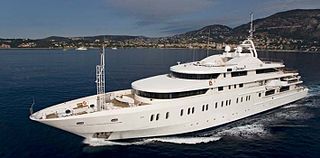
Delma is a private superyacht. It was pronounced the 27th largest private yacht in the year 2008 in Monte Carlo, Monaco. The Dubai-registered Delma measures length: 279 ft 7 • 85.23 m. It is available for charter.

The AeroVironment RQ-20 Puma is an American unmanned aircraft system which is small, battery powered, and hand-launched. Its primary mission is surveillance and intelligence gathering using an electro-optical and infrared camera. It is produced by AeroVironment.
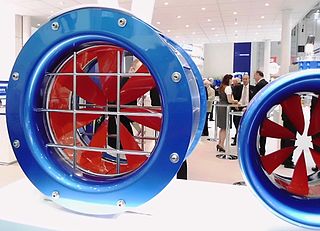
The rim-driven thruster, also known as rim-driven propulsor/propeller is a novel type of electric propulsion unit for ships. The concept was proposed by Kort around 1940, but only became commercially practical in the early 21st century due to advances in DC motor controller technology. As of 2017, commercial models of between 500 kW and 3MW are available from manufacturers such as Rolls-Royce, Schottel, Brunvoll, Voith, Van der Velden, etc.

A marine thruster is a device for producing directed hydrodynamic thrust mounted on a marine vehicle, primarily for maneuvering or propulsion. There are a variety of different types of marine thrusters and each of them plays a role in the maritime industry. Marine thrusters come in many different shapes and sizes, for example screw propellers, Voith-Schneider propellers, waterjets, ducted propellers, tunnel bow thrusters, and stern thrusters, azimuth thrusters, rim-driven thrusters, ROV and submersible drive units. A marine thruster consists of a propeller or impeller which may be encased in some kind of tunnel or ducting that directs the flow of water to produce a resultant force intended to obtain movement in the desired direction or resist forces which would cause unwanted movement. The two subcategories of marine thrusters are for propulsion and maneuvering, the maneuvering thruster typically in the form of bow or stern thrusters and propulsion thrusters ranging from Azimuth thrusters to Rim Drive thrusters.
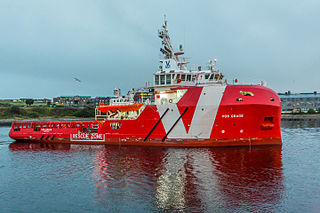
The MV VOS Grace is a platform supply vessel registered in the United Kingdom and operated by Vroon Offshore. Built in Fujian province, China the VOS Grace was chartered by the UK government to assist the Royal Fleet Auxiliary and Border Force in 2016 with operations rescuing migrants crossing the Aegean Sea during the European migrant crisis. The ship operated alongside RFA Mounts Bay of the Royal Fleet Auxiliary and the two Border Force cutters.


















